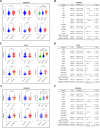Development and validation of a glioma-associated mesenchymal stem cell-related gene prognostic index for predicting prognosis and guiding individualized therapy in glioma
- PMID: 37005685
- PMCID: PMC10068170
- DOI: 10.1186/s13287-023-03285-9
Development and validation of a glioma-associated mesenchymal stem cell-related gene prognostic index for predicting prognosis and guiding individualized therapy in glioma
Abstract
Background: Recent studies have demonstrated that glioma-associated mesenchymal stem cells (GA-MSCs) are implicated in the regulation of glioma malignant progression. However, the prognostic value of GA-MSCs has not been comprehensively explored in glioma.
Methods: We extracted GA-MSCs from glioma tissues, established intracranial xenograft models in nude mice, and obtained GA-MSC-related genes (GA-MSCRGs) by using microarrays. The transcriptome data and clinical information of glioma patients were obtained from the CGGA and TCGA databases. We screened 8 prognostic GA-MSCRGs to construct a prognostic index by using the multivariate Cox regression method. The validity of the GA-MSCRGPI was verified in the training (CGGA693) and validation (TCGA and CGGA325) cohorts. The expression patterns of these 8 GA-MSCRGs were validated in 78 glioma tissue specimens by using a qRT‒PCR assay.
Results: GA-MSCs were successfully isolated from glioma tissues. Based on intracranial xenograft models and transcriptome microarray screening, 8 genes (MCM7, CDK6, ORC1, CCL20, TNFRSF12A, POLA1, TRAF1 and TIAM1) were selected for the construction of a GA-MSC-related gene prognostic index (GA-MSCRGPI). In both the training and validation cohorts, high GA-MSCRGPI patients showed an inferior survival outcome compared with low GA-MSCRGPI patients. A nomogram was established based on independent prognostic indicators (age, WHO grade and GA-MSCRGPI) and exhibited a strong forecasting ability for overall survival (OS). Moreover, we found that the GA-MSCRGPI could evaluate the prognosis of glioma patients undergoing chemoradiotherapy. The high GA-MSCRGPI group exhibited higher immune, stromal and ESTIMATE scores; lower tumor purity; higher infiltration of Tregs and M2-type macrophages; fewer activated NK cells; and higher expression of immune checkpoints. Tumor Immune Dysfunction and Exclusion (TIDE) showed that the high GA-MSCRGPI group had more responders to ICI therapy. The results of the genetic mutation profile and tumor mutation burden (TMB) in different GA-MSCRGPI subgroups further supplement GA-MSCRGPI-related mechanisms. Finally, the expression patterns of 8 selected GA-MSCRGs in GA-MSCRGPI were correlated with glioma WHO grades to a certain extent.
Conclusion: The constructed GA-MSCRGPI could predict prognosis and guide individualized therapy in glioma patients.
Keywords: Chemoradiotherapy; Genomic alterations; Glioma; Glioma-associated mesenchymal stem cells; Immune microenvironment; Immunotherapy; Prognosis.
© 2023. The Author(s).
Conflict of interest statement
The authors declare that they have no competing interests.
Figures








Similar articles
-
A Pyroptosis-Related Gene Prognostic Index Correlated with Survival and Immune Microenvironment in Glioma.J Inflamm Res. 2022 Jan 4;15:17-32. doi: 10.2147/JIR.S341774. eCollection 2022. J Inflamm Res. 2022. PMID: 35018108 Free PMC article.
-
A prognostic NAD+ metabolism-related gene signature for predicting response to immune checkpoint inhibitor in glioma.Front Oncol. 2023 Feb 8;13:1051641. doi: 10.3389/fonc.2023.1051641. eCollection 2023. Front Oncol. 2023. PMID: 36845744 Free PMC article.
-
Integrative Analysis of Inflammatory Response-Related Gene for Predicting Prognosis and Immunotherapy in Glioma.J Mol Neurosci. 2023 Aug;73(7-8):608-627. doi: 10.1007/s12031-023-02142-x. Epub 2023 Jul 25. J Mol Neurosci. 2023. PMID: 37488455 Free PMC article.
-
Ferroptosis-related gene signature correlates with the tumor immune features and predicts the prognosis of glioma patients.Biosci Rep. 2021 Dec 22;41(12):BSR20211640. doi: 10.1042/BSR20211640. Biosci Rep. 2021. PMID: 34726238 Free PMC article.
-
Identification of immune-related hub genes and construction of an immune-related gene prognostic index for low-grade glioma.J Cell Mol Med. 2023 Dec;27(23):3851-3863. doi: 10.1111/jcmm.17960. Epub 2023 Sep 29. J Cell Mol Med. 2023. PMID: 37775993 Free PMC article.
Cited by
-
Glioblastoma-Associated Mesenchymal Stem/Stromal Cells and Cancer-Associated Fibroblasts: Partners in Crime?Int J Mol Sci. 2024 Feb 14;25(4):2285. doi: 10.3390/ijms25042285. Int J Mol Sci. 2024. PMID: 38396962 Free PMC article. Review.
-
Limitations of nomogram models in predicting survival outcomes for glioma patients.Front Immunol. 2025 Mar 18;16:1547506. doi: 10.3389/fimmu.2025.1547506. eCollection 2025. Front Immunol. 2025. PMID: 40170838 Free PMC article.
-
Fusion of tumor cells and mesenchymal stem/stroma cells: a source of tumor heterogeneity, evolution and recurrence.Med Oncol. 2025 Jan 21;42(2):52. doi: 10.1007/s12032-024-02595-z. Med Oncol. 2025. PMID: 39838167 Review.
-
Tumor-associated mesenchymal stem/stromal cells in tumor microenvironment and carcinogenesis.Exp Hematol Oncol. 2025 Jul 17;14(1):97. doi: 10.1186/s40164-025-00688-7. Exp Hematol Oncol. 2025. PMID: 40676710 Free PMC article. Review.
-
Molecular biology of the deadliest cancer - glioblastoma: what do we know?Front Immunol. 2025 Mar 21;16:1530305. doi: 10.3389/fimmu.2025.1530305. eCollection 2025. Front Immunol. 2025. PMID: 40191211 Free PMC article. Review.
References
-
- Nicholson JG, Fine HA. Diffuse glioma heterogeneity and its therapeutic implications. Cancer Discov. 2021;11:575–590. doi: 10.1158/2159-8290.CD-20-1474. - DOI - PubMed
Publication types
MeSH terms
LinkOut - more resources
Full Text Sources

